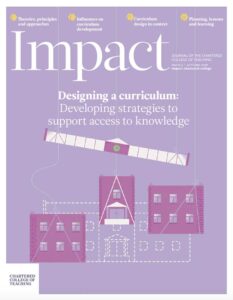Pedagogical patterns: Solving problems in curriculum design

I don’t need to tell you that teachers face a myriad of problems as they design a curriculum, develop a scheme of work or plan a lesson. The list of requirements is potentially endless, including the need to engage students, to incorporate effective collaboration, to develop mastery of content and subject-specific skills, to give effective feedback, and to provide opportunities for student-centred learning. As hours in the classroom add up, teachers learn – sometimes through CPD, sometimes through academic study, but often through trial and error – the activities that are effective in delivering the curriculum, so that when it comes to developing or revising a curriculum or scheme of work, they are able to do this so that it is well-designed and meets its aims.
What are the aims of curriculum design? For some, they are ensuring that students are prepared for the assessment outcome at the end of the curriculum content – in other words, ‘backward design’, as developed by Wiggins and McTighe (Biddell, 2014). For others, curriculum design must go beyond short-term assessment outcomes. In ‘What makes great pedagogy?’ (National College for Teaching and Leadership, 2012), James and Pollard are reported as stating that well-designed, pedagogically sound curricula must lead to an enduring understanding and capability in the area of learning, personal fulfilment and well-being, and a positive contribution to the economic prosperity of the nation or to greater social justice and inclusionAn approach where a school aims to ensure that all children.
Sound pedagogy is at the heart of this aim. Alexander (Alexander, 2004) defines pedagogy as meaning ‘ideas, values and evidence’ about ‘children, learning, teaching, curriculum and culture’.
A tool for ensuring that curricula are based on pedagogy, and which helps to address the aims mentioned earlier, is a pedagogical pattern. First developed in the 1990s, and used extensively in teaching computer science and technology-based courses, pedagogical patterns provide a method for communicating pedagogy; they try to capture expert knowledge and experiences of teaching and learning. By first identifying a pedagogical problem (what is the issue in teaching this concept?), and then by suggesting a pedagogical solution (a teaching and learning activity), they enable teachers to think more deeply about their curriculum design and engage with pedagogy.
A pattern structure comprises four elements: title, problem, context and solution, as shown below in Figure 1.

This pattern comes from a set of patterns developed by Joseph Bergin called ‘Active Student’ (Bergin et al., 2002). It supports the aims of curriculum design by focusing on students developing an enduring understanding and capability in their learning, and in recognising that some students may find this harder than others; it therefore acknowledges the needs of children as holistic learners.
Patterns borrow a language and structure from pattern design in architecture; here, patterns are defined as ‘a problem which occurs over and over again in our environment, and then describes the core of the solution to that problem in such a way that you can use this solution a million times over without ever doing it in the same way twice’ (De Moura Filho and Derycke, 2005). In education, patterns are worded so that individual teachers can use their own creativity to implement the pattern in a way that is most comfortable for them and most useful for their students.
Putting more than one pattern together creates a ‘pattern language’, a linked series of patterns that describes a way to design a scheme of work, a series of lessons in a topic or individual lessons on a sub-topic.
I have used pattern language when designing curricula and lessons for Key Stage 4 and 5 psychology. An example of a pattern language that I have used is given in Figure 2; it focuses on students being active. Having been taught research methods in psychology for several weeks, students are at the stage where they are able to design, conduct and write up their own research. I used a ‘real world experience’ pattern for the design and conduct phase, an ‘exhibition’ pattern (Sipos, 2002) for writing the report, and an ‘invisible teacher (peer feedback)’ pattern to continue the active student theme, as students were responsible for assessment using agreed criteria.
Figure 2 below shows an example of an Active Student pedagogical pattern language: ‘real world experience’ plus ‘exhibition’ plus ‘invisible teacher (peer feedback)’.



Pedagogical patterns offer a format and a process for sharing successful practices in a way that allows them to be used by a variety of people in many different ways (Eckstein et al., 2001). Researchers who work in the pedagogical pattern field make their work freely available through the Pedagogical Pattern Project website, an international project with individuals from more than 12 different countries (see references); alternatively, a quick Google search will provide many resources. Existing patterns are easily adapted to meet the needs of different subjects whilst retaining their core pedagogy. For new and experienced teachers alike, they are a useful addition to any toolkit for designing effective curricula.










